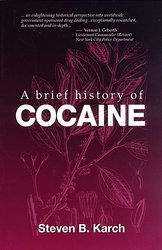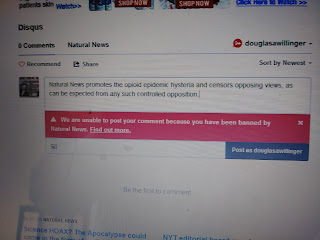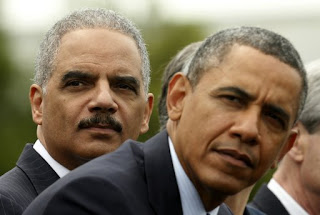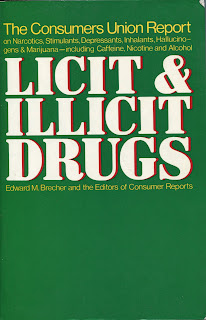Dilute Cocaine in Vin Mariani, Coca-Cola & Harvey Wiley - According to Steven B. Karch
A Brief History of Cocaine - Steven B. Karch
pp 100-102
If our drug policies appear convoluted today, think how they must have looked to the owners of the Coca-Cola Company just after the turn of the century. In 1911, company officials found themselves in federal court, charged with, among other things, not putting cocaine in Coca- Cola. Popular histories of this period usually lump Coca-Cola with the [sic] other quack nostrums [sic- a nostrum is simply a medicated liquid meant to be take orally], often suggesting that the problem of cocaine abuse in America was, in some way, connected to the successes of the Coca-Cola Company. Except for the titillation factor, the idea has little to recommend it. Even when Coca-Cola contained cocaine, the amounts were trivial; too small to produce measurable physiological or behavioral changes. Coca-Cola was not responsible for America's cocaine problem, but government harassment of the Atlanta soft drink maker did mark an important turning point in the development of American drug policy, and is worth examining in some detail.
Government moves against Coca-Cola were orchestrated by Dr. Harvey Wiley, a zealous bureaucrat. Wiley was the first head of the Bureau of Chemistry within the Department of Agriculture, the agency responsible for enforcing the Pure Food and Drug Act of 1906. Wiley was one in a series of government officials, such as Hamilton Wright and Harry Anslinger, who made their living by campaigning against the evils of drug abuse. These anti drug crusaders had more in common than just the desire to rid society of its drug problem; all were willing to use very bad, sometimes fraudulent science to advance their arguments. The duel problem of "drug careerism", and the tendency to use political considerations as a means of determining scientific truth, have not gone away. However, the issues were more clearly framed at the turn of the century.
During the early 1900s, the patent medicine [sic- a 'patent medicine' would be something that is patentable, aka a synthetic creation today known as a 'pharmaceutical', what is referred to here are actually 'proprietary medicines' generally blended compounds of naturally existing substances] market was crowded and fiercely competitive [ahh!!- generally meaning less expensive]. No central registry for these products ever existed, but informed estimates suggest that, at one time, more than 25,000 different patent medications were for sale in the United States. As is true today, the success or failure of a new product was determined by the amount of money producers could spend on advertising. Millions upon millions were spent promoting these products, and since the market was completely unregulated, even the most outrageous claims were permitted. Revenues from patent [sic] drugmakers turned publishers into lobbyists for the drugmakers. Drug producers offered long term advertising contracts, but the contracts all contained automatic cancellation clauses, if by some accident, laws were passes prohibiting sales of heir product. The publishers, of course, made every effort to see that that did not occur.
While some of the claims for Angelo Mariani's wine may have been overblown, there never was any doubt that the product contained wine and coca. Using only coca leaf meant that there was a limit on how much cocaine Mariani could get into the wine. By the mid 1890s, however, there was a glut of cocaine on the market, and patent [sic] drugmakers were able to dump large amounts of cocaine into their products [sic- I've seen no indication of this with the beverages, rather the problem were types of preparations meant for more direct use, such as intranasal or by injection], making them very popular, but addictive [sic- a better term would be 'toxic-maniac] and dangerous.
The medical literature of the late 1800s contains dozens of reports describing severe, occasionally lethal, reactions to cocaine anesthesia. But as far as anyone knows, no one ever became ill, let alone addicted, to Vin Mariani, or any other coca-based wine. Vin Mariani contained only a very small amount of cocaine, probably less than 6 mg per ounce, not enough to cause toxicity. When combined with alcohol, however, a 6 to 8 ounce serving would have been more than enough to create feelings of well being. The real secret behind Vin Mariani's success was not even known to Mariani, and was only discovered more than a century later.
In the late 1980s, the number of cocaine-related deaths in Miami, Florida began to explode. lee Hearn, a toxicologist with the Miami Dade County Medical Examiner office, and Deborah Mash, a neurochemist at the University of Miami, first noted that when the deceased had been drinking alcohol and using cocaine at the same time, a new molecule, somewhat like cocaine, could be detected in their urine. These observations were confirmed by Peter Jatlow at Yale, and another group of scientists in Barcelona. It is now clear that cocaethylene has most of the same stimulant properties as cocaine, but that it lasts much longer. Even though the cocaine content of Mariani's wine was relatively low, mixing the cocaine with alcohol resulted in a much higher effective dose!
Coca-Cola contained even less cocaine than Vin Mariani. According to a formulation held by the great-grandson of Frank Robinson, one of Coca-Cola's founders, 10 pounds of coca leaf were used to make 36 gallons of syrup. Coca leaf from South America contains very little cocaine, probably less than 0.5%, and not all of that can be extracted. Thus Coca-Cola, as originally produced, would have contained about 100 mg of cocaine per gallon (10lb=22.5 kg, 55 x 22.5 kg = 112 mg) or 1.5 mg per ounce, only one-fourth the amount of cocaine found in Vin Mariani. Such minute amounts of cocaine would certainly not have been enough to produce a detectable physiological response, and it is absurd to suggest that Coca-Cola ever had addictive properties, or that its cocaine content was responsible for its success. Coca-Cola was successful for the very same reason that Vin Mariani was successful: it was brilliantly promoted. Coca-Cola's managers were better salesmen than Mariani's, and Coca-Cola prospered, while Mariani gradually lost market share. Coca-Cola continued to grow and prosper long after the cocaine had been dropped from the original formula. Vin Mariani was not so well promoted, and after World War I, it simply faded from existence.





Comments
Post a Comment